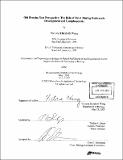Old protein, new perspective : the role of Oct-1 during embryonic development and lymphopoiesis
Author(s)
Wang, Victoria Elizabeth, 1973-
DownloadFull printable version (6.696Mb)
Other Contributors
Massachusetts Institute of Technology. Dept. of Biology.
Advisor
Phillip A. Sharp.
Terms of use
Metadata
Show full item recordAbstract
B cell development consists of an ordered program of rearrangement and transcriptional events, leading ultimately to the expression of immunoglobulin (Ig) molecules. This process involves the interaction of cis acting elements with trans acting factors. The octamer element (5'ATGCAAAT-3') is conserved in Ig promoters and enhancers and is thought to be important in transcriptional regulation. To date, only two octamer-binding proteins have been identified in B cells, the ubiquitously expressed Oct-1 and the lymphoid restricted Oct-2. While biochemical evidence suggests that Oct-i and Oct-2 exhibit identical DNA binding specificity, their respective roles in vivo have not been clearly defined. B cell development proceeds normally in mice deficient for Oct-2 and the B cell specific coactivator OCA-B/OBF-1/Bob-1 but these experiments were complicated by the presence of Oct-1 in the cells. In order to understand the degree of functional redundancy shared by homologous members of this family, a genetic model of Oct-i was created using gene targeting. The targeting strategy replaced exon 3, which encodes part of the transactivation domain, with a loxP-flanked neomycin cassette in the antisense transcriptional orientation. Any potential transcript derived from the targeted allele would harbor frameshift mutations, resulting in the deletion of the DNA binding POU domain. These animals are embryonic lethal with erythropoietic defects of variable penetrance due to a selective reduction of β-globin expression. Cells derived from these embryos show a 40-fold decrease in protein activity and 30-fold decrease in total detectable Oct-i polypeptides as well as a complete lack of octamer-dependent promoter activity in vivo. (cont.) Furthermore, replication of herpes simplex virus is impaired in Oct-i deficient cells. Surprisingly, functional lymphocytes with surface IgM expression comparable to wildtype cells can be generated from E13.5 Oct-i deficient embryos by adoptive transfer, albeit at slightly reduced numbers. When Oct-1 +/- animals were crossed with Oct-2 +/- animals, the transheterozygous offsprings were recovered at a decreased Mendelian frequency, suggesting a cooperative role for these two proteins in mediating survival.
Description
Thesis (Ph. D.)--Massachusetts Institute of Technology, Dept. of Biology, 2003. Vita. Includes bibliographical references.
Date issued
2003Department
Massachusetts Institute of Technology. Department of BiologyPublisher
Massachusetts Institute of Technology
Keywords
Biology.